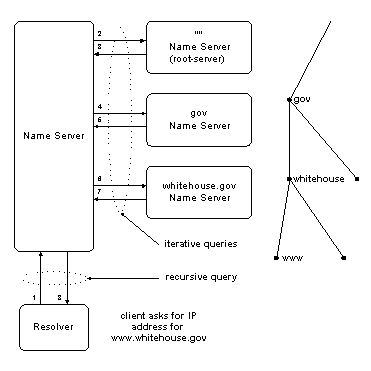
There are three types of queries that a client can make to a DNS server, recursive, iterative and inverse. While discussing name resolution, keep in mind that a DNS server can be a client to another DNS server.
In a recursive query, the queried name server is petitioned to respond with the requested data, or with an error stating that data of the requested type doesn't exist or that the domain name specified doesn't exist. The name server can not just refer the querier to a different name server.
This type of query is typically done by a DNS client (a resolver) to a DNS server. Also, if a DNS server is configured to use a forwarder, the request from this DNS server to its forwarder will be a recursive query.
In an iterative query, the queried name server gives the best answer it currently has back to the querier. This type of query is typically done by a DNS server to other DNS servers after it has received a recursive query from a resolver.
The following figure shows an example of both types of queries. Query 1/8 is a recursive query from a client resolver to its DNS server while 2/3, 4/5, and 6/7 are iterative queries from the DNS server to other DNS servers.

What if a resolver has the IP Address and would like to know the Host name for a particular machine? Instead of supplying a name and asking for an IP address, the client needs to provide the IP address and asks for the name. Since there is no direct correlation in the DNS name space between the domain names and the associated IP addresses they contain, only a thorough search of all domains could guarantee a correct answer.
To alleviate this problem, a special domain "in-addr.arpa." in the DNS name space was created. Nodes in the in-addr.arpa domain are named after the numbers in the dotted-octet representation of IP addresses. But since IP addresses get more specific from left to right and domain names get less specific from left to right, the order of IP address octets must be reversed when building the in-addr.arpa tree. With this arrangement, administration of lower limbs of the DNS in-addr.arpa tree can be given to companies as they are assigned their class A, B, or C subnet address.
Once the domain tree is built into the DNS database, a special pointer record is added to associate the IP addresses to the corresponding host names. In other words, to find a host name for the IP address 157.55.200.2, the resolver would query the DNS server for a pointer record for 2.200.55.157.in-addr.arpa. If this IP address was outside the local domain, the DNS server would start at the root and sequentially resolve the domain nodes until he reached 200.55.157.in-addr.arpa which should contain the resource PTR record for 2 (that is 157.55.200.2).